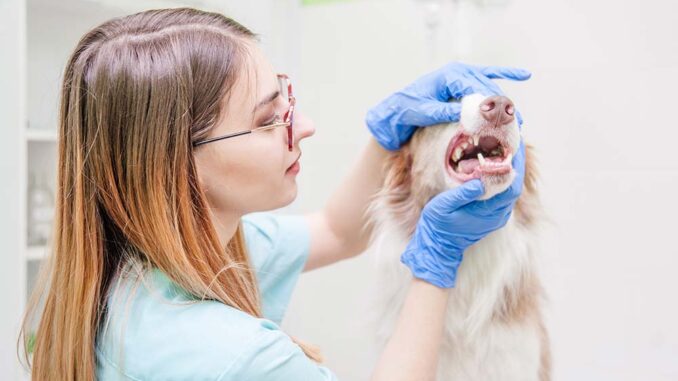
One day a client called because she found a loose tooth in her dog’s mouth when she was brushing his teeth. Knowing her furbaby was an adult, I explained that loose teeth can be a sign of certain conditions and suggested she bring her dog in for an exam.
In this article, I’ll explain what to do if your dog has a loose tooth, whether and how long it takes loose teeth to fall out, and how much vets usually charge to extract a dog’s tooth. I’ll also describe how your veterinarian will diagnose a tooth problem, other symptoms to watch for, and the causes of loose teeth. We’ll finish with how to know when it’s time to head to the vet and the signs of an emergency.
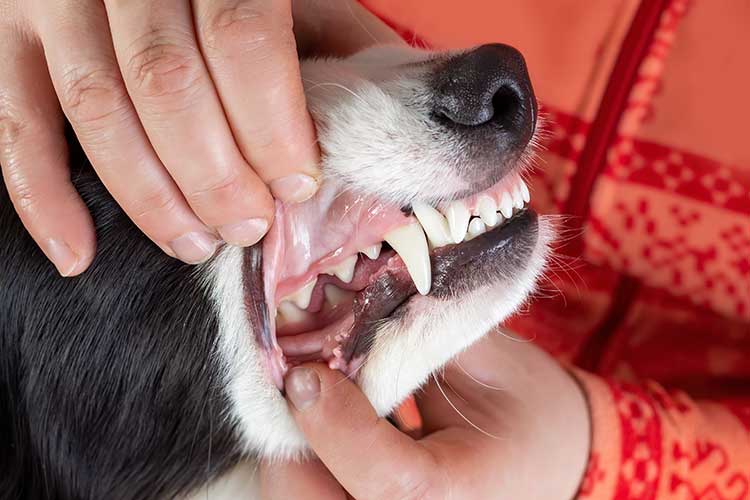
What should I do if my dog has a loose tooth?
What you do for a loose tooth in your dog depends on his age. If your furbaby is young, it may be a baby tooth. Most dogs lose their baby teeth by about 7 months of age, but sometimes, teething can be delayed. If the loose tooth is a baby tooth, and it’s white and still attached to the root, you can let it fall out naturally.
For adult dogs with permanent teeth, loose teeth usually indicate an underlying condition that requires veterinary care. You may be tempted to leave the tooth until it falls out or to pull it out, but this can be quite dangerous and painful for your pooch. When you notice a loose adult tooth, contact your veterinarian. He can examine your dog and run diagnostic tests. Additionally, he can sedate your dog to safely extract the tooth.
Is my dog in pain?
If your dog is losing a baby tooth, he probably won’t notice it. However, loose adult teeth can be very painful. It’s not normal for adult dogs to lose their teeth, so it usually means there’s a problem. Your furbaby could have periodontal disease with inflammation, a broken tooth, or another condition.
How long does it take a loose tooth to fall out?
With puppies, the loose teeth usually fall out by the time your furbaby is 7 months, but the timeline can vary from dog to dog. Adult dogs should never have loose teeth, so when they do, the teeth may be rotting or damaged.
The time it takes for loose adult teeth to fall out depends on the nature of the underlying condition. However, it’s best to seek veterinary care if your dog has a wiggly tooth. Some diseases that cause loose teeth can be extremely painful for your furbaby. The doctor can examine your pup’s mouth and advise you whether it should be extracted or left in the mouth.
Can loose teeth in dogs heal on their own?
When adult dog teeth are loose due to a disease condition, they will not heal on their own. If you notice a wobbly tooth in your dog’s mouth, you should schedule an appointment with your veterinarian. There’s a good chance your furbaby has a condition that could be painful or harmful to his health.
If your dog suffers trauma that dislocates the tooth from its normal position in the socket, your veterinarian may be able surgically replace the tooth and fix it in place. It will usually take 4-6 weeks for the tooth to reimplant in its socket. If the tooth remains unstable or loose, it will need to be removed.
Will my dog’s loose tooth fall out on its own?
If your dog has a loose tooth, it may eventually fall out on its own. Depending on the underlying condition, however, tooth loss may leave your pup’s tooth root exposed, and this is extremely painful. When you find an unstable tooth in your dog’s mouth, take him to the vet for an exam. Chances are, the doctor will recommend extraction.
How much does it cost to get a tooth removed at the vet?
The cost to extract a dog’s tooth varies depending on the location of the tooth, the underlying condition, and the part of the country you live in. Extraction is painful, and your dog will require anesthesia. If the tooth is abscessed, or there is periodontal disease, your veterinarian will prescribe antibiotics. Overall, the cost ranges from $150-600 or more.
Other symptoms to watch for and what they could mean
When dogs have dental issues that cause loose teeth, you should check for other symptoms that might clue you into the underlying problem.
Bad breath
Also known as halitosis, bad breath in your dog is a common side effect of periodontal disease and other oral/dental conditions. The odor comes from bacteria that form biofilms in the mouth. If your dog has stinky breath, it’s time to visit the vet.
Reddened or bleeding gums
Dogs’ gums are normally light-pink or pigmented and appear shiny and moist. So, redness or bleeding around the gum line means your dog has an underlying condition such as gingivitis. Red and bleeding gums which characterize gingivitis are the first signs of periodontal disease. Gums may also appear red and bleed due to recent trauma or injury.
Excessive drooling
Naturally, periodontal disease or broken/damaged teeth are painful for your dog. Inflammation in the mouth triggers the salivary glands to produce extra saliva to help protect the oral cavity and other body systems from infection. The increased production results in excessive drooling.
Pawing at the mouth
Conditions that cause loose teeth in dogs, such as periodontal disease or fractured teeth, are painful. One way your furbaby will tell you his mouth is hurting is by pawing at his face.
Difficulty chewing/dropping food
When your dog’s mouth is painful, it’s not surprising that they have difficulty chewing kibble. If your dog is taking extra care when he eats or starts dropping food, it may indicate a condition like periodontal disease, a tooth root abscess, a broken tooth, or cancer.
Facial swelling
Severe inflammation from trauma or tooth abscesses can cause swelling. If you notice your dog’s face starting to swell, he may have an abscess or a fractured tooth. Contact your veterinarian and schedule an examination.
Painful/tender mouth
Conditions like periodontal disease and trauma can cause your pup pain. Depending on the severity and location of the pain, your dog may whimper or cry when he tries to eat something. He may resist your attempts to examine his mouth. If your pooch is showing signs of mouth pain, approach him with caution. It’s probably best to let your veterinarian examine him.
Lumps/bumps in the mouth
If you find a lump or bump in your dog’s mouth, it could be a sign of a tooth abscess or cancer. Either condition can cause bony changes that result in loose teeth.
Causes of loose teeth in dogs
Periodontal disease
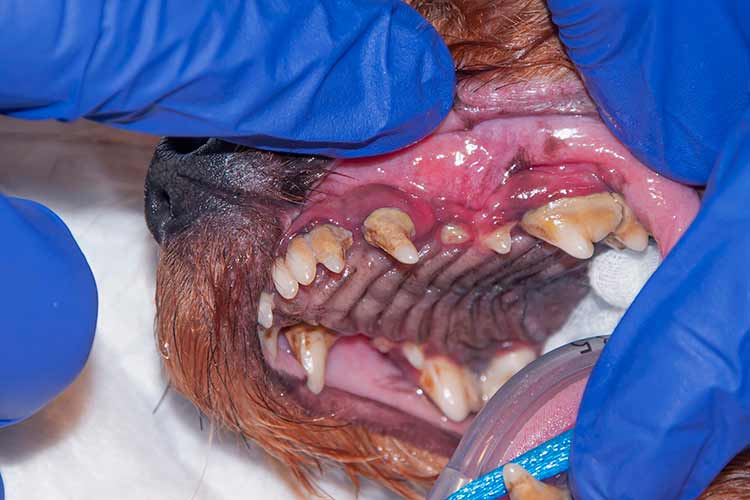
When bacteria grows and forms biofilms in the mouth, it leads to plaque and tartar buildup. Eventually, there can be an infection in the tissue around the teeth. At first, the gums become inflamed and reddened. As the disease spreads, it damages the gums, ligaments, and bone surrounding one or more teeth resulting in loose teeth. Signs of periodontal disease include:
- Red, inflamed gums
- Gums bleed easily when touched or teeth are brushed
- Discolored teeth that appear yellow or brown
- Receding gums
- Excessive drooling
- Bad breath/halitosis
- Bloody saliva
- Pawing at the mouth
The treatment for periodontal disease will depend on the severity of the condition. Early on, professional dental cleaning to remove plaque and tarter will suffice. If your dog’s gum disease is more advanced, and there are periodontal pockets, your vet will clean under the gum line and may antibiotic gel to help the pockets heal. When there’s significant damage to the tissue, and teeth are loose, your vet may extract diseased teeth.
Injury/fractured tooth
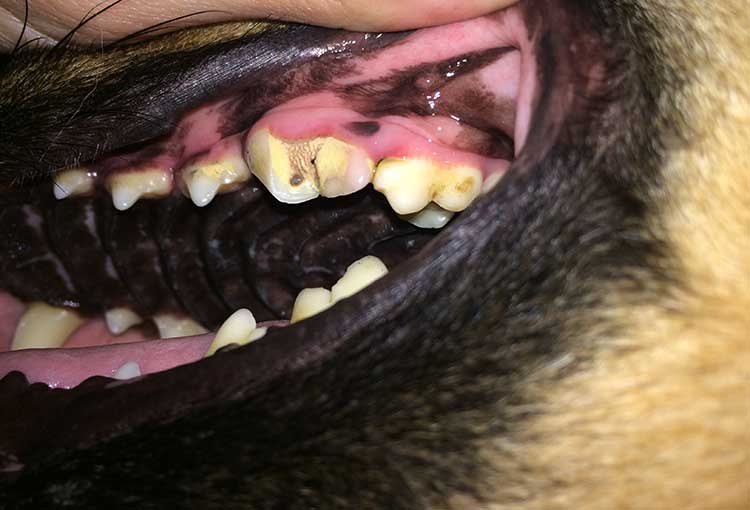
If your dog experiences trauma to the mouth, there can be injury to a tooth. Whether your dog is in a fight, has an accident, or bites something hard, he may suffer dental damage. If a tooth is broken, the pulp chamber is exposed and causes your dog pain. Additionally, bacteria can enter the fracture and infect the tooth root. Signs of a fractured tooth include:
- Constant mouth pain
- Bleeding or deep pink tissue near the fracture
- Inflammation
- Refusing to chew food, treats, or toys
- Chipped or cracked tooth(not always evident)
If your dog’s tooth is chipped, but no dentin is exposed, your veterinarian may recommend watching it or repairing it with a crown. Fractures that expose the pulp but don’t extend to the root may be treatable with a root canal to remove the pulp and insert materials to prevent infection. Teeth that are severely fractured or also diseased are usually extracted.
Cancer
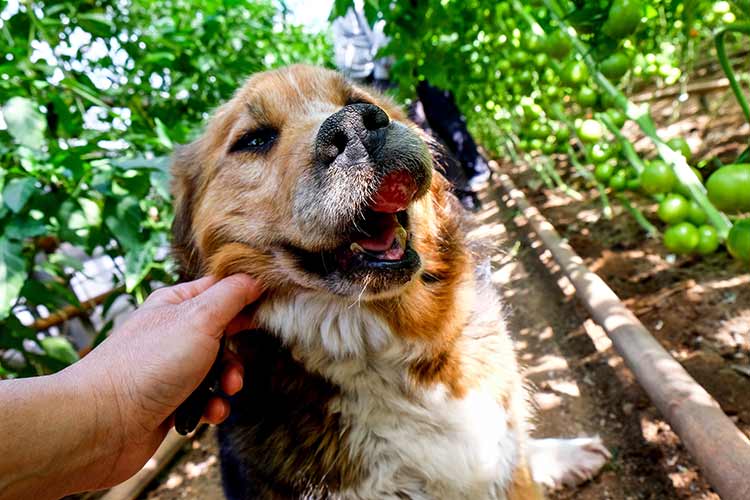
When cancer affects the gums or the jaw bones, it can cause damage to the bone, gums, and ligaments that hold teeth in place. Oral cancers usually occur in older dogs and can appear in the roof of the mouth, the gums, or involve the bone. The main types of oral tumors are malignant melanoma, squamous cell carcinomas, and fibrosarcomas. Symptoms of oral cancer include:
- Halitosis
- Excessive drooling
- Difficulty eating
- Bleeding from the mouth
- A growth or lump in the mouth
- Facial swelling
- Weight loss
- Enlarge regional lymph nodes in some cases
When cancer causes loose teeth, the treatment of choice is extraction. Depending on the type of tumor your dog has, your veterinarian may recommend surgical removal. Many times, up to half of the jaw may need to be resected to get clean margins. Other treatment methods include radiation or chemotherapy, particularly when the tumor has metastasized to other organs.
How will the vet diagnose my dog’s teeth problems and how much will it cost?
If your dog has one or more loose teeth, your veterinarian will begin with a history of recent injuries, overall health, and symptoms of the problem. After that, he’ll conduct a physical examination including an oral exam. The initial office visit usually costs about $50-150.
Depending on his findings, the doctor may anesthetize(the cost of anesthesia varies from about $90-1200) your dog to take x-rays of the teeth. Mouth radiographs generally cost $150-250. While your dog is under anesthesia, your vet will be able to examine the teeth and gums more closely to determine the severity of your dog’s condition. The comprehensive oral exam runs about $55-90.
What are the signs that I need to take my dog to the vet?
Take your dog to the vet if you notice:
- One or more adult teeth that are loose
- Bleeding from the mouth
- Reddened gums
- Bad breath
- Mouth pain
- Dropping food or difficulty chewing
- Facial swelling
- Lumps or bumps in the mouth
- Pawing at the mouth
Any time your dog has a loose adult tooth, he should be seen by a veterinarian. Taking a wait-and-see approach may lead to further damage or infection and result in a more painful condition for your dog.
When is a loose tooth an emergency?
When your dog has a loose tooth that exposes the pulp or tooth root, the condition is extremely painful for your furbaby. Take your dog to your veterinarian or the emergency clinic as soon as possible to relieve his discomfort. Signs of mouth pain include:
- Resistance to having his mouth touched(may pull away, growl, or snap)
- Pawing at the mouth
- Hypersalivation
- Bleeding from the mouth
- Dropping food or refusing to eat
- Restlessness/pacing or hiding behavior
Is there anything else I should know?
While there are no guarantees, some things you can do at home to prevent loose teeth in your dog include:
- Schedule annual exams with your veterinarian. Part of a routine examination includes looking in the mouth to evaluate oral health. Early detection can help prevent conditions that cause loose teeth.
- Brush your dog’s teeth daily to remove food residue that feeds bacteria. Use a product made specifically for dogs like Vet’s Best Dog Enzymatic Toothpaste because many human products contain ingredients that are not safe for dogs.
- Schedule routine dental cleanings to remove plaque and tartar from your dog’s teeth. During the procedure, your veterinarian will also be able to check the gum line and teeth for evidence of periodontal disease or other conditions.
- Give your dog treats and toys that are safe for them to chew. Check with the Veterinary Oral Health Council for a list of dog-safe products.
Disclaimer: This website's content is not a substitute for veterinary care. Always consult with your veterinarian for healthcare decisions. Read More.


Be the first to comment